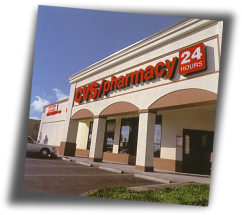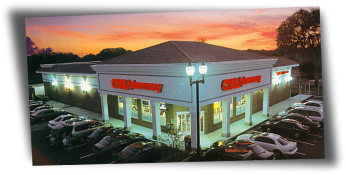...and convenient...

"We place a high priority on selecting prime locations,
which offer our
customers convenient access to CVS and
generate strong sales."
|
Real Estate Strategy

Our new Tampa store represents entry into a
high-growth market that capitalizes on the Company's name recognition among the thousands of people
who have migrated from current CVS markets.
|
The location and expansion of our store base are critical components of CVS' success. We place a high priority on both the quality of the markets we enter and the sites we select. We focus on three key strategies: 1) entering new markets, 2) adding stores within existing markets, and 3) relocating stores to more convenient, freestanding sites. During 2000, we opened a total of 388 stores, including new stores, relocations and ProCare apothecaries.
Through sophisticated analysis that includes extensive market research and the use of proprietary CVS software systems, our CVS Realty team is able to identify the prime locations for our stores, right down to a specific corner at an intersection. We take advantage of statistical and in-the-field research, as well as our own spatial modeling software, to reach important conclusions about the various demographic and other factors that drive growth in our stores. As a result, when we open a new store or enter a new market, we can be confident in the potential of the investments we are making and their ability to deliver an attractive return on invested capital over the long term.
We remain committed to carefully controlled and managed growth and, in that regard, the vast majority of new market stores will be delivered through our highly successful preferred developer program. These arrangements afford us maximum flexibility and have greatly mitigated occupancy costs, as the pricing of these transactions reflects our superior credit worthiness.
We currently operate stores in 59 of the top 100 U.S. markets. In 34 of those markets, we are the #1 drugstore chain. The 41 top markets we are not in represent enormous untapped potential for two reasons: their populations are growing and they are underserved. In 2001, we expect more than one third of all new CVS stores will be in new markets. Our growth plan is structured to allow us to achieve this goal while sustaining strong earnings growth.
|
Through sophisticated analysis, CVS is able to pinpoint prime locations for new stores, such as our new
store in Orlando pictured below, which will deliver attractive returns on invested capital over the long term.

|
New High-Growth Markets
In 2000, we entered four new markets: Chicago, Illinois; Grand Rapids, Michigan; and Tampa and Orlando, Florida. Chicago is the 2nd largest drugstore market in the U.S., and our expansion here supports our strategy to grow in high-quality markets with substantial potential. Our early results suggest that these stores will exceed our expectations.
We also launched an aggressive growth initiative in Florida. During 2000, we opened stores in Tampa, the 16th largest market in the U.S., and in Orlando, the 27th largest market, and we have plans to enter Fort Lauderdale, the 23rd largest market, in 2001. These are especially promising markets for CVS; the population in these Florida locations is expected to grow at a rate three times that of the population in our most successful markets. Our strong name recognition precedes us among thousands of people who have migrated to Florida from northern cities where CVS already has a strong presence.
Our entry into the Grand Rapids market was a natural extension from our #1 position in Detroit, the 4th largest drugstore market. Since our acquisition
of Michigan-based Arbor Drugs, Inc. in 1998, we have reinforced and built upon our presence in this highly attractive market.
Economic Lift from Relocations
Store relocations, the third leg of our real estate strategy, are highly productive investments for CVS. When we relocate a store from an inline shopping center to a freestanding, convenient corner location, we typically generate 25% to 35% higher front-end sales, improved margins and a better return on invested capital than the stores they replace. The new sites, which are in higher-profile locations with convenient parking, have more appeal to consumers. Today, nearly 40% of our stores are in freestanding locations. Our goal over the next five to seven years is to reach 80%. Although the number of relocations will decrease over time, our relocation strategy will remain an important component of our overall growth strategy.
